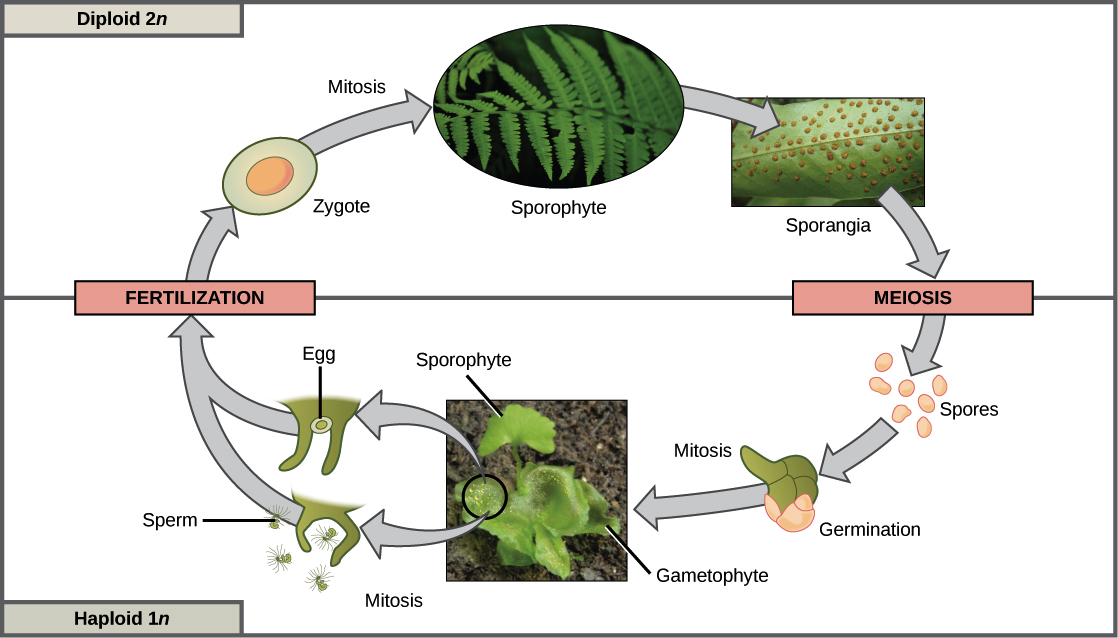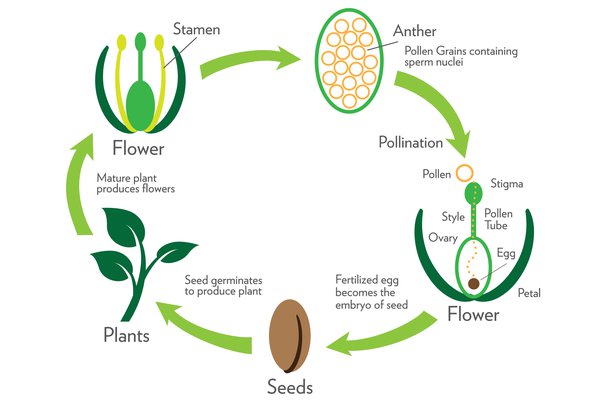Plant Reproduction and Life Cycle Study Guide
Plant Reproduction and Life Cycle
All plants are living things with a life cycle, similar to humans and other animals. The plant life cycle can be described through their reproduction cycles. Wilhelm Hofmeister demonstrated that alternating generations is a feature that is common among plants.
The plant reproductive cycle switches between haploid and diploid generations, allowing for both asexual and sexual reproduction. The generalized life cycle for land plants is thus said to undergo “alternation of generations“, as the sporophyte and gametophyte generations alternate with one another to complete the entire process of sexual reproduction.
Plant Reproduction Sequence and Structures
Each plant has different structures that serve different functions in growth, survival, and reproduction. The sequence of reproductive processes in plants form structures such as:
-
Gamete Formation: Ovule and pollen
-
Pollination: Pollen reaches the stigma of a flower
-
Germination: Pollen germinates and forms a pollen tube that reaches the ovary, and the male gamete is released.
-
Fusion: Male gamete fuses with female gamete and forms zygote.
-
Embryo Formation: The zygote divides numerous times to form an embryo
-
Seed Development: Seeds germinate under favorable conditions to produce a seedling.
-
Flowering Plant Seeds: The embryo is formed from the zygote, the endosperm is formed by double fertilization, and the seed coat is formed by maternal tissue of the ovule.
How do Plants Reproduce Sexually and Asexually?
The plant reproductive system uses different strategies for species continuation. Some plants reproduce sexually (sexual reproduction) while others reproduce asexually (vegetative reproduction).
Sexual Reproduction in plants usually depends on pollinating agents, while asexual reproduction is independent of these agents. The flower is the basic reproductive organ of plants that produces seeds through sexual reproduction. In most plants, seeds serve as the primary method by which individuals of the species are dispersed across the landscape to facilitate reproduction.
Vegetative Reproduction, on the other hand, is a natural process of asexual reproduction that does not entail the union of sex cells or gametes and results in new plant “individuals” without the production of seeds or spores.
Plant Sexual Life Cycle
-
The plant life cycle involves two distinct stages: the Gametophyte Stage and the Sporophyte Stage.
-
During the Gametophyte Stage, the haploid Gametophyte produces distinct multicellular structures called the male and female Gametes.
-
The male and female gametes fuse during fertilization to create a diploid Zygote.
-
The zygote develops into a still-diploid Sporophyte, thus marking the entry into the sporophyte stage of the plant life cycle.
-
The diploid sporophyte produce Spores through meiosis.
-
These spores divide through mitosis to once again produce haploid gametophytes, which will once again produce gametes, and the cycle repeats.

Sporangium
A Sporangium is a capsule-like structure belonging to certain plants and fungi in which the reproductive spores are produced and stored.
Spores are haploid structures created in organisms that help to germinate without fertilization and can spread through wind and animals to form new organisms.
All land plants undergo an alteration of generations to reproduce, and the sporangium is borne upon the sporophyte, which is the asexual second-generation structure.

✅ Conclusion
-
Plant life cycle biology must be taught engagingly to make students understand the importance of plants to all life on Earth.
-
The reproduction of flowering plants can serve as a useful topic for teaching botany.
-
As plants produce oxygen, fuel, food, and fiber, scientists use knowledge about plant reproduction to increase plant yield, grow them more efficiently using fewer resources.
-
Helps to identify new sources of bioactive compounds and medicines, biofuels, and bio-renewable resources and improve fiber production.
FAQs
1. What are the 5 stages of the plant life cycle?
The 5 main plant reproduction steps involved in the life cycle are: Seed, Germination of Seeds, Seedling growing to attain maturity, Flowering, Pollinating, Seedling and Seed Dispersion;
2. What is reproduction and life cycle?
According to plant reproduction definition, it is the production of biologically or genetically identical offspring to the parent organism unless mutations occur. Sexual reproduction is the fusion of gametes that produces genetically different offspring, and asexual reproduction produces new plants without the fusion of gametes. The life cycle of a plant is the time it takes from germination of the seed to the production of seed or completion of reproduction of that plant. This process varies greatly, depending on whether it is annual or perennial.
3. What is the life process of reproduction in plants?
Plants undergo a variety of life processes that help them to grow and reproduce. The seven life processes involve gaining nutrition, excretion, growth, reproduction, sensitivity, respiration, and movement.
4. What are the 3 life cycles of a plant?
The 3 plant sexual life cycle are, Haplontic, Haplo-diplontic (or Diplo-haplontic) and Diplontic.
5. What are the 6 stages of the plant life cycle?
The six major stages of the life cycle of a flowering plant are the seed stage, germination, growth, reproduction, pollination, and seed dispersal.
6. What are the 4 stages of a plant?
The plant life cycle consists of four stages, namely seed formation, sprout, small plant, and adult plant.
7. In which stage is a plant able to reproduce?
When a plant becomes an adult or the reproductive stage, it starts to grow flower that produces seeds that help further the procreation of the species.
We hope you enjoyed studying this lesson and learned something cool about Plant Reproduction and Life Cycle! Join our Discord community to get any questions you may have answered and to engage with other students just like you! Don’t forget to download our App to experience our fun, VR classrooms – we promise, it makes studying much more fun! 😎
]]>
